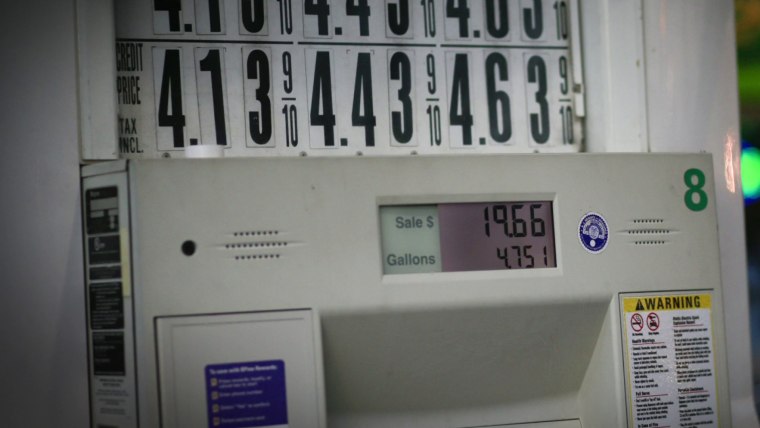What’s really behind America’s pain in front of the pump
Every time gas prices spike, the same questions arise: Why are gas prices so high? Who to blame? What will bring them down?
These are not terrible questions and they make sense in a country where most people are car owners. But the fact that we continually have these questions, decade after decade, shows that they are not enough either. They narrow their focus to short-term, weak-fix solutions to which elected officials, eager to avoid being blamed for the obscene pain at the pump, rush in. The president taps the reserves. The governor suspended the gas tax. Never mind that these stopgap measures don’t do much attract consumers until prices drop. Indeed, on Tuesday, President Joe Biden announced the plan increase production and sale of gasoline mixed with ethanol; this happened just a few weeks after he announced his release plan millions of barrels of oil from the Strategic Petroleum Reserve.
Why are gas price fluctuations so painful? The answer, of course, is to park in an American driveway.
A better question might be: Why do gas price swings have the power to cause so much pain? The answer, of course, is to park in an American driveway.
AAA calculated last year that gas only 16% of the annual cost of owning a compact SUV and driving it 15,000 miles (The annual average). Last month, the national average price of a gallon reached $4.34. We’ve come down from that peak, but if it’s sustained for a year, gas will only reach 25% – 1 out of 4 – of the cost that the same vehicle owner incurs.
What this tells us is that when it comes to cost, gas isn’t the crux of the matter – cars are. What the gas price spike does is disrupting the fantasy that our transportation system, which relies so heavily on cars, is sustainable.
This fantasy persists because a lot of family vehicle costs are hidden. (That’s not to mention external costs.) Gas station signs are easy to see, but many of the costs of owning and operating a car are broken down into our budget, often with automatic payments: finance, depreciation, insurance, repair, maintenance, taxes, fees, fines, parking, tolls. Gas prices go up and down, sometimes violently right before our eyes, but these other, easily overlooked costs continue to rise.
The average price of a new car hit a new high last year of $47,000. Aggressive marketing by automakers for larger, more expensive – demanding vehicles, Long-term liabilities, stretch budgets to the limit and tend to consume more fuel – driving gas prices much higher than is necessary for middle-class people. Because periods of lower gas prices seem to contribute to memory loss of their volatility, Light trucks, vans and SUVs now outsell cars by 3 to 1. It is these buyers, especially those who put pressure on politicians, who respond by fostering the belief that lowering gas prices is the ultimate answer.
Importantly, while a small percentage of household spending on vehicles goes to the government to help finance roads, most goes to the giant corporations that sell cars, lend to buy cars. and offers auto insurance. The result is, Our transportation system is a tool for inequalitysucks dollars from low- and middle-income families, small businesses, and local communities and injects them into not only big oil but also big banks, big insurance, and big autos.
And while high gas prices will certainly hit low-income workers the most, the cost of car ownership crushes the poor regardless of gas prices. An unlikely source, an Applebee executive, states that many people have been working longer hours lately to pay for the car they need to get to work. He’s been rightly derided, but he’s not wrong about this: Our reliance on cars can get people into terrible jobs, while corporations are big enough to weather the rise. Gasoline mutations are beneficial in a way we couldn’t imagine.
Many supporters keeping the air flowing is appropriate for working families, but too many people come up with the wrong solutions, including predictable calls for more drilling in the country. But all the evidence – society, economic, environmental – demonstrate that we need to reduce our dependence on petroleum, and The current. Electric cars can help, but waiting for the car to solve its problems has led us to this point: the brink of disaster.
We have been waiting for the electric cars that can save us any time for decades. Today they explain to less than 1 percent of vehicles on our roads. Reinforcing the belief that cheap gas or electric cars will solve our transportation problems isn’t too narrowly focused on automotive solutions – it has slowed progress on solutions are not cars. Transport critics complain that it can take decades for public transit investments to materialize, and assert that agile private companies can deliver a better future fast. more quickly. They have been proven wrong.
So what to do? It has to be made safer and easier so people can drive less and become more mobile through smarter planning, low-cost pedestrian and cyclist infrastructure, and significantly improved and expanded means of transport. And if owners realize they can spend more on their car than they imagine and can spend less to get what they need, they could help drive down gas prices. the next increase a little less.
at Blogtuan.info – Source: nbcnews.com – Read the original article here




